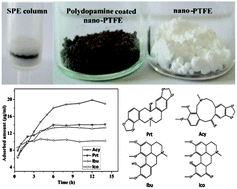Evaluation of polydopamine supported nano-polytetrafluoroethylene as a novel material for solid phase extraction
Abstract
A novel material for

* Corresponding authors
a
Key Laboratory of Chemistry of Northwestern Plant Resources and Key Laboratory for Natural Medicine of Gansu Province, Chinese Academy of Sciences, Lanzhou Institute of Chemical Physics, Lanzhou 730000, China
E-mail:
didl@licp.cas.cn
Fax: +86 931 8277088
Tel: +86 931 4968248
b Graduate University of the Chinese Academy of Sciences, Beijing 100049, China
A novel material for

 Please wait while we load your content...
Something went wrong. Try again?
Please wait while we load your content...
Something went wrong. Try again?
Y. Liu, J. Liu, X. Sun and D. Di, New J. Chem., 2012, 36, 2376 DOI: 10.1039/C2NJ40582B
To request permission to reproduce material from this article, please go to the Copyright Clearance Center request page.
If you are an author contributing to an RSC publication, you do not need to request permission provided correct acknowledgement is given.
If you are the author of this article, you do not need to request permission to reproduce figures and diagrams provided correct acknowledgement is given. If you want to reproduce the whole article in a third-party publication (excluding your thesis/dissertation for which permission is not required) please go to the Copyright Clearance Center request page.
Read more about how to correctly acknowledge RSC content.
 Fetching data from CrossRef.
Fetching data from CrossRef.
This may take some time to load.
Loading related content
